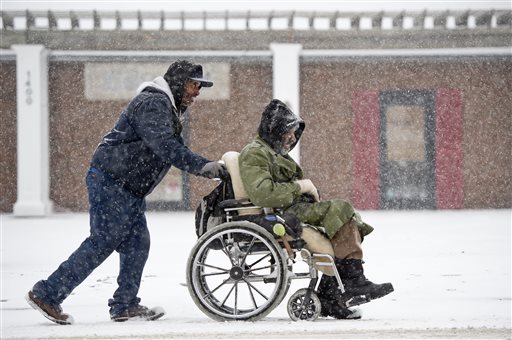Don’t Get Left Out in the Cold: Winter Weather Advisory for People with Disabilities

Craig Kelley, left, pushes his uncle, James Poole, in his wheelchair during a snowstorm in Kansas City, Mo. on Tuesday, Feb. 4, 2014. A winter storm bore down on Missouri Tuesday, dumping enough snow to make roads treacherous and forcing the cancellation of dozens of flights and hundreds of schools. Eight to 11 inches of snow were forecast across a large portion of northern and central Missouri, said Mike July, a meteorologist with the National Weather Services office in the Kansas City suburb of Pleasant Hill. (AP Photo/The Kansas City Star, Jill Toyoshiba)
Severe winter weather arrived much earlier than usual this year, catching many people by surprise. In fact, there have been more than 400 record lows and record cool-highs in 43 states, just since November. While that sounds like the perfect excuse to stay indoors, curled up with some hot cocoa, venturing outdoors is a must for some of us. From commuting to work in your wheelchair accessible vehicle to visiting friends and family following the busy holiday season, here are some hot winter safety tips for people living with disabilities.
Function Over Fashion
Dress in layers. Air gets trapped between the layers and acts as insulation. Wearing multiple layers of clothing also gives you the ability to remove layers when you perspire or add them when you get chilled.
Try to avoid wearing cotton clothing, as it will stay wet once it gets wet. Consider moisture wicking, polypropylene and other lightweight, man-made fabrics.
Wear warm gloves. Gripper driving gloves not only keep your hands warm but can help prevent slipping when sleet or ice stick to wheelchairs and other surfaces. Carry an extra pair of gloves with you, in case one pair gets wet.
Save Face
Use sunscreen. People don’t think about it but when the sun reflects off of snow, severe sunburns can occur.
Another good idea is to use Vaseline on exposed areas of your face. It helps prevent your face from getting dry or chapped by acting as a moisture insulator.
Getting Around
Using a wheelchair in snow can be very strenuous, especially if you’re not accustomed to it. Always be careful when maneuvering through the snow, as the extra exertion could have negative effects on your body. If possible, have somebody with you to help.
Pneumatic tires or those made from soft rubber can give wheelchairs better traction on snow and ice. An alternative is to use mountain bike tires that have knobby treads.
Always take your time on slippery surfaces so you don’t go into a slide and lose control. Be especially mindful while driving a mobility vehicle and keep our winter driving tips for maneuvering over slush, ice and snow in mind.
Batteries can lose 60% of their charge when temps get cold, so keep them warm with covers.
Make sure you take proper care of your handicap accessible vehicle by following the appropriate winter car-care suggestions.
Don’t Forget Fido
Dogs can suffer from hypothermia and frostbite, too. If you’re accompanied by a service animal or taking a pet outside, consider a dog coat and boots for their feet. It’s also a good idea to keep a blanket in your vehicle for your pet.
Do you have any tips or tricks for getting around or staying warm during the winter months? Share your top tips with us on Facebook, Twitter and Pinterest!
The National Mobility Equipment Dealers Association (NMEDA) is an advocate for mobility and accessibility for drivers with disabilities. If you need help with converting or buying a handicap accessible car, truck or van, please consider one of our mobility equipment dealers.
